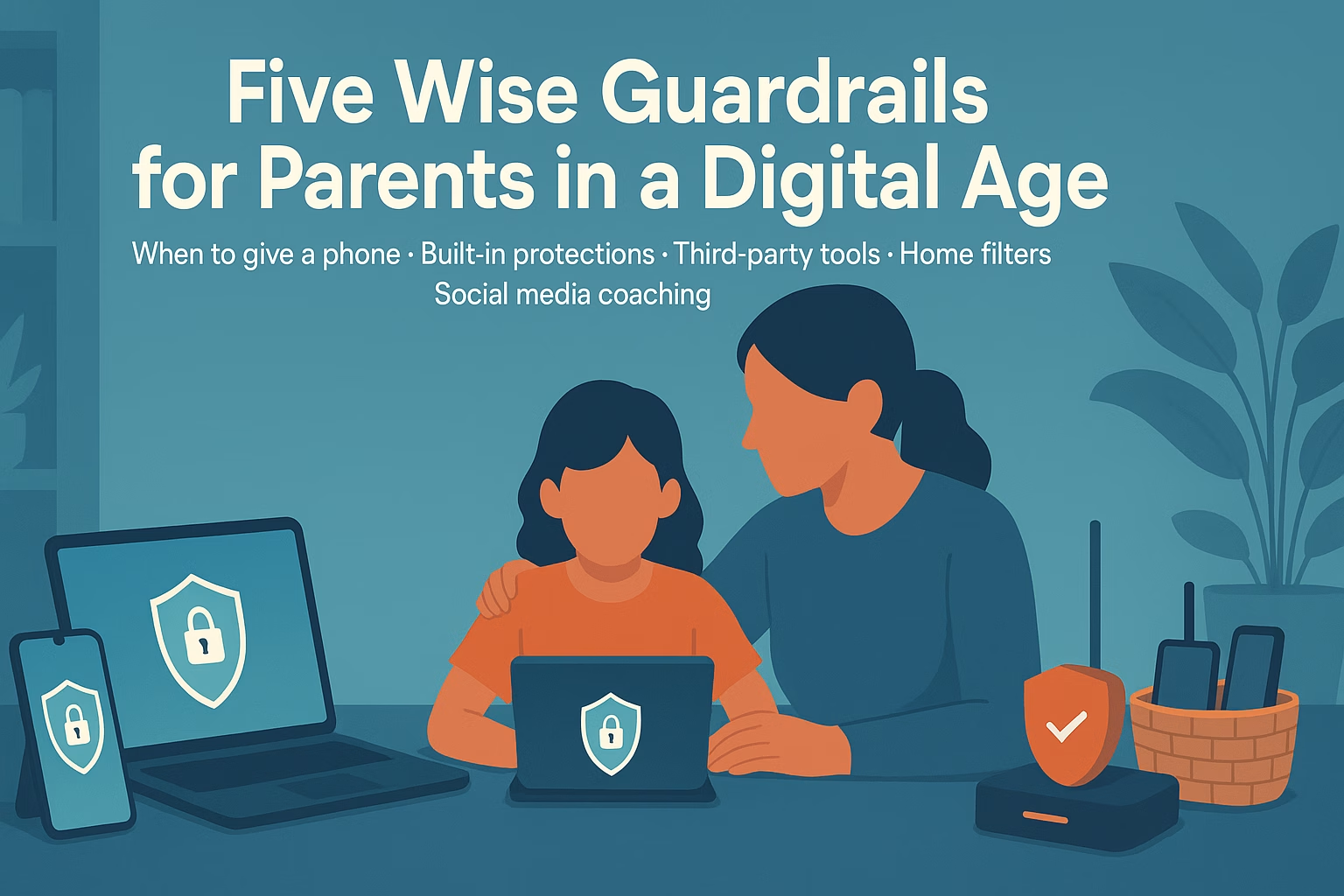As a parent, raising children in this digital age can be incredibly difficult. We have smart devices all around us. Whether it be computers, tablets, phones, smartwatches, smart speakers, or smart TVs, we face real difficulties in navigating and protecting our children from content that could harm them emotionally, spiritually, and developmentally.
Last week’s widely shared reporting on the killing of Charlie Kirk at Utah Valley University pushed violent footage onto many students’ feeds, jolting families into fresh conversations about digital safety. Additionally, health leaders caution that the safety of social media for adolescents remains unestablished and recommend exercising caution, providing coaching, and establishing clear family norms. These guardrails aim to strike a balance between wisdom, relationships, and practical tools to help you, as a parent, think through parenting in a digital age.
1. Decide when and what to give
Every child is a bit different in maturity. Generally, I’d argue that it is unwise to hand a child a cellphone until they are old enough to drive. They have an expected maturity, according to the government, that the child is mature enough to handle a vehicle. Yet, here’s the thing. A cellphone contains access to material that is not appropriate for anyone to view. Also, it is connected to the internet, where both good and evil live. Yes, it is a tool that can be beneficial, but it is also a powerful tool in Satan’s arsenal. Is this a great time to give a child an iPhone, Pixel, or some other phone? Not necessarily. Is your child spiritually ready to handle that kind of responsibility? Some may be, while others may not be. Yet, a cellphone is helpful in emergencies, for avoiding getting lost, and in other ways. Is a cellphone helpful in this season of a child’s life? Yes, it can be.
There is also the reality that many parents give their child a cellphone long before this age. If you have already given your child a phone, is there any way to help safeguard their eyes, mind, and heart? Thankfully, there are a few options available. I will spend some time pointing these out.
2. Turn on built-in safety features
Both Apple and Google provide helpful safety and age-appropriate safeguards within their operating systems. I’m most familiar with Apple’s application because we utilize it for the devices our children use for school. We have iPads that our school-aged children use to access their school videos. However, an iPad has as much access as a cell phone. What we did was block all websites except for school-related ones. We locked down content to be only for their ages and made it mandatory for us to approve all downloads. These are basic and easy features to set up. Here’s a great article from Apple on the tools they have built into their platform (https://www.apple.com/families/). Google also provides some helpful information on their tools (families.google/familylink). These are not perfect options, but they give you the ability to help safeguard kids to specific ages. However, that means that once they reach a level that these companies deem appropriate to have full access, you lose these tools. So what about then?
3. Add a third-party layer
I don’t have any experience with this personally yet. However, I do follow many of them. I am not endorsing one over the other, and several of these do different things better than others. However, I encourage you to look into each of these yourself and see which one is best for you. Keep in mind that all of these come with financial costs, so please do plenty of research before committing to one.
A. Bark provides some incredible tools. They are also one of, if not the best, resources in this area. You can follow the link to check out their offerings: https://www.bark.us
B. Aura, they like bark provides some incredible tools to protect your children and family. You can follow this link to see their product: https://www.aura.com
C. Norton, yes, the PC security company. They have a fairly good reputation and rating in this area as well. Here’s their link: https://us.norton.com
As you can see, there are plenty of options available, but this will at least get you started in exploring some of the tools companies have developed for parents to keep children safe.
4. Change the environment
We all live busy lives, and sometimes it just isn’t possible to be in the room with your child while they are using their devices. A general rule that can help protect children from exploring the dark internet corners. It is to have a no devices in their rooms policy. While this won’t eliminate all potential dangers, it will hinder them. Consider setting up a general charging station in your room, where everyone can charge their devices. The temptation to grab it while mom and dad are asleep in their room dramatically decreases if it is in your room to begin with. Forcing them to use their devices in public spaces helps prevent those late-night curiosities, which can give rise to deep-seated issues and exposure to bad actors.
Also, your Router/DNS should have filtering built in. You can implement some safeguards that will further enhance the protection of your child using this free tool.
5. Delay social media—and coach, not just police
This one is going to be the most difficult one that you will face with your children. When you give them a phone, they will want to have social media because Susie and Johnny down the street do. Regardless of the safeguards in place, social media remains a dangerous environment. There is no shortage of bad information, vile topics, inappropriate content, violence, and so much more that takes place in the public spaces, not to mention the chat spaces. Snapchat, for example, is one that has chats and images that disappear, making it hard to properly monitor your child’s interactions. I don’t have a Snapchat for this reason. However, it is not just Snapchat that has problematic issues. There are sex predators that are using these platforms pretending to be around the age of the child and convincing them to send inappropriate images and, in the most dangerous situations, meet-ups. I’d recommend not allowing your child to have any social media until 18. However, if you feel that is too old, I would still say the earliest is 16, with regular monitoring. Even then, I’d say, what is the harm of two more years? Social media’s impact on children is still being researched, and there are some studies that suggest that it leads to depression and other mental health struggles.
Parenting is hard. With the digital age fully established, I’d suggest that parenting is becoming harder. Just know that if you commit to protecting your children from the dangers of the digital age. It will require a lot of dialogue and being willing to acknowledge that it is okay not to have a phone when your friends do. Just know that peer pressure could easily lead to them also feeling left out and even not included in the lives of classmates. It is a difficult journey. However, there are resources and tools to help us protect our children from the world that desires to devour them. My final encouragement to you is to think twice before you give your children the keys to accessing all the world has to offer.



